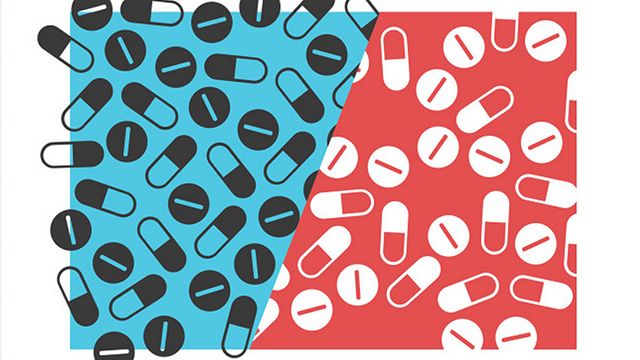This story first appeared at ProPublica and was co-published with The New York Times’ The Upshot.

Health insurance companies are no longer allowed to turn away patients because of their pre-existing conditions or charge them more because of those conditions. But some health policy experts say insurers may be doing so in a more subtle way: by forcing people with a variety of illnesses — including Parkinson’s disease, diabetes and epilepsy — to pay more for their drugs.
Insurers have long tried to steer their members away from more expensive brand name drugs, labeling them as “non-preferred” and charging higher co-payments. But according to an editorial published Wednesday in the American Journal of Managed Care, several prominent health plans have taken it a step further, applying that same concept even to generic drugs.
The Affordable Care Act bans insurance companies from discriminating against patients with health problems, but that hasn’t stopped them from seeking new and creative ways to shift costs to consumers. In the process, the plans effectively may be rendering a variety of ailments “non-preferred,” according to the editorial.
“It is sometimes argued that patients should have ‘skin in the game’ to motivate them to become more prudent consumers,” the editorial says. “One must ask, however, what sort of consumer behavior is encouraged when all generic medicines for particular diseases are ‘non-preferred’ and subject to higher co-pays.”
I recently wrote about the confusion I faced with my infant son’s generic asthma and allergy medication, which switched cost tiers from one month to the next. Until then, I hadn’t known that my plan charged two different prices for generic drugs. If your health insurer does not use such a structure, odds are that it will before long.
The editorial comes several months after two advocacy groups filed a complaint with the Office of Civil Rights of the United States Department of Health and Human Services claiming that several Florida health plans sold in the Affordable Care Act marketplace discriminated against HIV patients by charging them more for drugs.
Specifically, the complaint contended that the plans placed all of their HIV medications, including generics, in their highest of five cost tiers, meaning that patients had to pay 40 percent of the cost after paying a deductible. The complaint is pending.
“It seems that the plans are trying to find this wiggle room to design their benefits to prevent people who have high health needs from enrolling,” said Wayne Turner, a staff lawyer at the National Health Law Program, which filed the complaint alongside the AIDS Institute of Tampa, Florida.
Turner said he feared a “race to the bottom,” in which plans don’t want to be seen as the most attractive for sick patients. “Plans do not want that reputation.”
In July, more than 300 patient groups, covering a range of diseases, wrote to Sylvia Mathews Burwell, the secretary of health and human services, saying they were worried that health plans were trying to skirt the spirit of the law, including how they handled co-pays for drugs.
Generics, which come to the market after a name-brand drug loses its patent protection, used to have one low price in many insurance plans, typically $5 or $10. But as their prices have increased, sometimes sharply, many insurers have split the drugs into two cost groupings, as they have long done with name-brand drugs. “Non-preferred” generic drugs have higher co-pays, though they are still cheaper than brand-name drugs.
With brand names, there’s usually at least one preferred option in each disease category. Not so for generics, the authors of the editorial found.
One of the authors, Gerry Oster, a vice president at the consulting firm Policy Analysis, said he stumbled upon the issue much as I did. He went to his pharmacy to pick up a medication he had been taking for a couple of years. The prior month it cost him $5, but this time it was $20.
As he looked into it, he came to the conclusion that this phenomenon was unknown even to health policy experts. “It’s completely stealth,” he said.
In some cases, the difference in price between a preferred and non-preferred generic drug is a few dollars per prescription. In others, the difference in co-pay is $10, $15 or more.
Even small differences in price can make a difference, though, the authors said. Previous research has found that consumers are less likely to take drugs that cost more out of pocket. “There’s very strong evidence for quite some time that even a $1 difference in out-of-pocket expenditures changes Americans’ behavior” regarding their use of medical services, said the other co-author, Dr. A. Mark Fendrick, a physician and director of the University of Michigan Center for Value-Based Insurance Design.
Fendrick said the strategy also ran counter to efforts by insurance companies to tie physicians’ pay to their patients’ outcomes. “I am benchmarked on what my diabetic patients’ blood sugar control is,” he said. “I am benchmarked on whether my patients’ hypertension or angina” is under control, he said. Charging more for generic drugs to treat these conditions “flies directly in the face of a national movement to move from volume to value.”
If there are no cheaper drugs offered, patients might just skip taking their pills, Fendrick said.
The authors reviewed the drug lists, called formularies, of six prescription drugs plans: Harvard Pilgrim Health Care in Massachusetts; Blue Cross Blue Shield of Michigan; Blue Cross and Blue Shield of Illinois; Geisinger Health Plan in Pennsylvania; Aetna; and Premera Blue Cross Blue Shield of Alaska. They wanted to see how each plan handled expert-recommended generic drugs for 10 conditions.
The conditions are not all high cost like HIV and Parkinson’s. They also include migraine headaches, community acquired pneumonia and high blood pressure.
Premera and Aetna had preferred generic drugs for each of the 10 conditions the authors examined. Harvard Pilgrim, a nonprofit often considered among the nation’s best, did not have a lower-cost generic in any of the 10 categories.
Four of the six plans had no preferred generic antiretroviral medication for patients with HIV.
In a statement to ProPublica, Harvard Pilgrim said it charges more for some generics because they are more expensive. The cheapest generics carry a $5 co-payment for a 30-day supply. More expensive generics range from $10 to $25, or 20 percent of the cost for a 30-day supply. The health plan said its members pay less for their medications than the industry average.
Blue Cross and Blue Shield of Illinois said that its preferred generics had no co-payment at all, and that non-preferred generics cost $10. “We historically only had one tier of generic drugs at a $10 co-pay,” the spokeswoman Mary Ann Schultz said in an email.
The Blue Cross Blue Shield of Michigan spokeswoman Helen Stojic said the editorial looked only at its drug plan for Medicare patients, which the government closely regulates. Under Medicare, patients can appeal a drug’s tier and seek to pay a lower co-payment, she said.
Geisinger did not respond to questions.
Health plans that participate in Medicare’s prescription drug program, known as Part D, have been moving rapidly to create two tiers of generic drugs. This year, about three-quarters of plans had them, according to an article co-written by Jack Hoadley, a health policy analyst at Georgetown University’s Health Policy Institute. The practical effect of such arrangements probably varies based on the difference in cost, he said.
Dan Mendelson, chief executive of Avalere Health, a consulting firm, has studied the way in which health insurers structure their benefits. He said the increasing number of drug tiers in some plans was confusing for patients.
“Consumers often don’t understand which drugs are where,” he said. “They don’t understand the purpose of tiering. They just get to the pharmacy counter and it gets done to them.”


